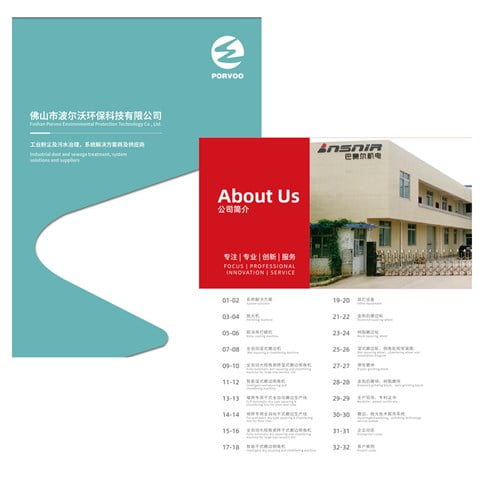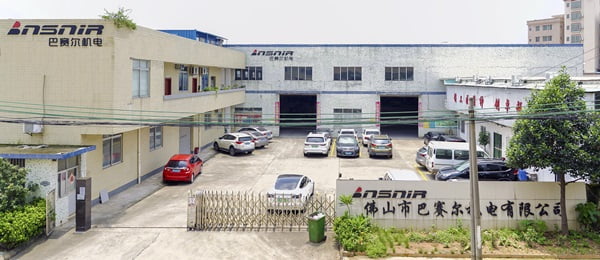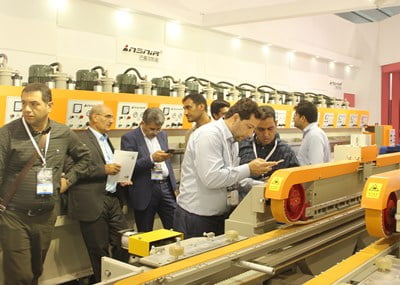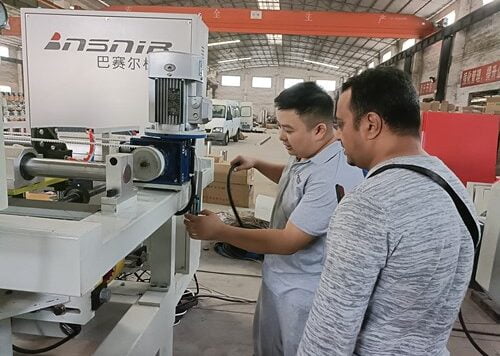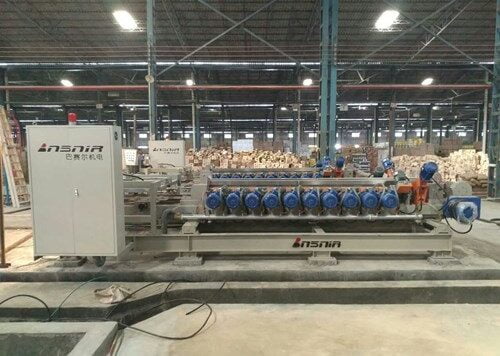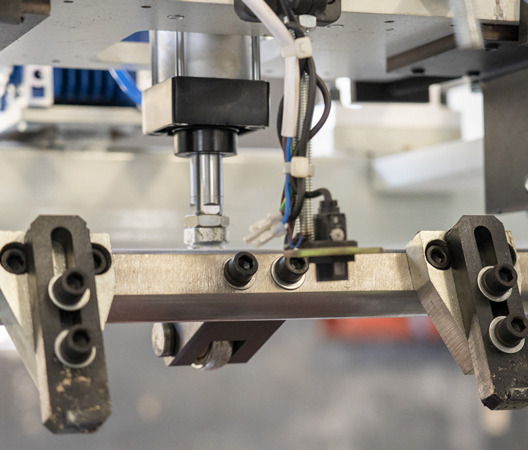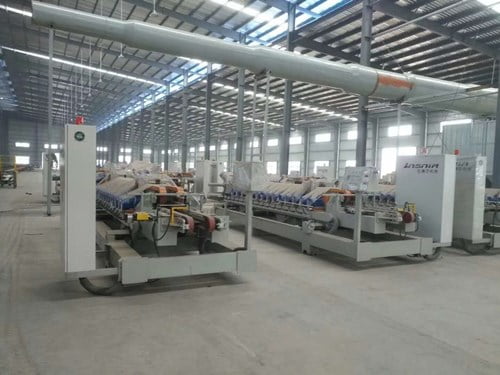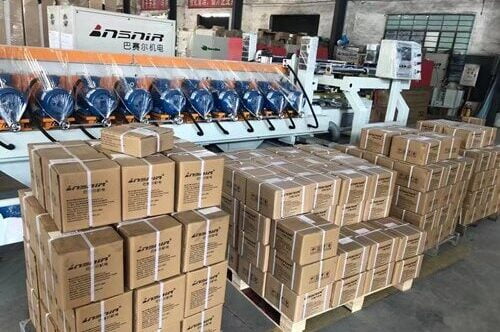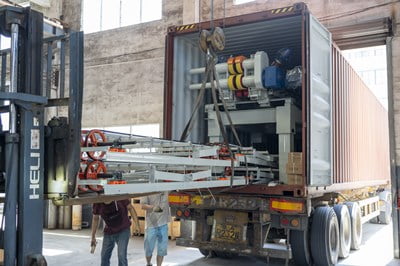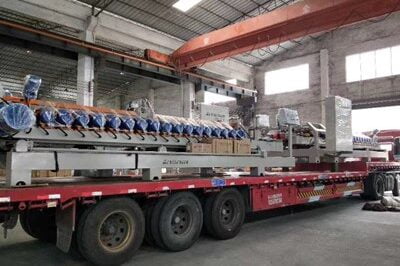The ceramic tile manufacturing industry faces a critical juncture where aging polishing lines struggle to meet modern production demands while new equipment investments require substantial capital commitments. Many manufacturers operate polishing systems installed 10-20 years ago, experiencing declining efficiency, increased maintenance costs, and quality inconsistencies that directly impact their competitive position in an increasingly demanding market.
This challenge becomes particularly acute when considering that replacement costs for complete polishing lines can exceed $500,000-$2 million, depending on capacity and specifications. However, the consequences of maintaining outdated equipment extend beyond immediate operational concerns – reduced throughput, higher energy consumption, and inability to achieve contemporary surface quality standards can result in lost market share and diminished profitability over time.
Fortunately, strategic equipment upgrades offer a viable pathway to modernize existing polishing lines while preserving significant portions of your initial investment. This comprehensive analysis examines proven upgrade strategies, cost-benefit considerations, and implementation approaches that enable manufacturers to transform legacy systems into competitive, efficient production assets.
What Determines the Viability of Ceramic Tile Polishing Line Upgrades?
The feasibility of upgrading existing ceramic tile polishing lines depends on several critical factors that manufacturers must carefully evaluate before committing resources to modernization projects. Understanding these determinants helps establish realistic expectations and guides strategic decision-making throughout the upgrade process.
Structural Foundation Assessment
The mechanical foundation of your existing polishing line serves as the primary constraint for potential upgrades. Lines manufactured within the last 15 years typically feature robust steel frameworks capable of supporting enhanced machinery and control systems. However, older installations may require structural reinforcement to accommodate modern equipment loads and vibration characteristics.
Mechanical wear patterns provide valuable insights into upgrade potential. Excessive wear in main drive systems, bearing assemblies, or conveyor mechanisms often indicates that line modernization efforts should prioritize these components. In our experience, lines showing minimal structural degradation but outdated control systems represent the most promising candidates for cost-effective upgrades.
Production Capacity Alignment
Current production requirements versus existing line capacity creates the foundation for upgrade justification. Manufacturers processing 15,000-25,000 square meters daily often find that targeted upgrades can increase throughput by 20-35% without complete line replacement. This improvement typically results from enhanced automation, optimized polishing sequences, and reduced changeover times.
| Upgrade Scenario | Capacity Increase | Investment Range | Payback Period |
|---|---|---|---|
| Control System Only | 10-15% | $75,000-$150,000 | 18-24 months |
| Partial Automation | 20-30% | $200,000-$400,000 | 24-36 months |
| Comprehensive Modernization | 35-50% | $500,000-$800,000 | 36-48 months |
Technology Compatibility Evaluation
Modern polishing requirements demand precision control systems that integrate seamlessly with existing mechanical components. Legacy lines equipped with pneumatic controls can typically accommodate digital upgrade packages, while older relay-based systems may require extensive rewiring and component replacement.
The compatibility between existing polishing heads and contemporary abrasive technologies plays a crucial role in upgrade success. Lines designed for traditional resin-bonded abrasives often struggle with modern ceramic bonds and diamond tools without mechanical modifications. However, advanced polishing systems demonstrate how proper integration can achieve exceptional results even with mixed-generation components.
How Can Digital Control Systems Transform Legacy Polishing Lines?
Digital control integration represents the most impactful single upgrade available for ceramic tile polishing lines, offering immediate improvements in consistency, efficiency, and operational flexibility. Modern control systems can transform manual or semi-automatic operations into fully automated production environments while maintaining compatibility with existing mechanical infrastructure.
Automated Process Control Benefits
Contemporary control systems eliminate human variability in critical polishing parameters such as pressure distribution, speed regulation, and sequence timing. These systems monitor real-time conditions and adjust operations automatically to maintain optimal surface quality across varying tile specifications and production conditions.
Pressure control improvements alone can increase polishing consistency by 40-60% compared to manual operations. Digital systems maintain precise pressure profiles throughout the polishing sequence, ensuring uniform surface development regardless of operator skill levels or attention fluctuations. This consistency directly translates to reduced rejection rates and improved product quality.
Integration with Existing Mechanical Systems
The technology upgrade process for control systems typically requires 5-7 days of installation work, depending on line complexity and existing wiring infrastructure. Modern control packages include adaptive interfaces that communicate with legacy sensors and actuators while providing advanced diagnostic capabilities.
Retrofit control systems offer several advantages over complete replacement:
- Preservation of proven mechanical components
- Reduced installation complexity and downtime
- Maintenance of existing operator knowledge base
- Incremental learning curve for production staff
Data Collection and Analysis Capabilities
Modern control systems provide unprecedented visibility into polishing line performance through comprehensive data logging and analysis tools. These systems track production rates, energy consumption, abrasive wear patterns, and quality metrics to identify optimization opportunities and predict maintenance requirements.
According to recent industry research, manufacturers implementing digital control upgrades report 25-40% improvement in overall equipment effectiveness (OEE) within six months of installation.
The data analysis capabilities enable predictive maintenance strategies that reduce unplanned downtime by 35-50%. Control systems monitor component wear patterns, vibration signatures, and performance trends to schedule maintenance activities during planned production breaks rather than responding to unexpected failures.
What Are the Most Cost-Effective Equipment Renovation Strategies?
Successful equipment renovation requires strategic prioritization of upgrade components based on their impact on production efficiency, quality improvement, and return on investment. Manufacturers must balance immediate operational needs with long-term modernization goals while managing capital expenditure constraints.
Phased Upgrade Implementation
The most successful renovation projects follow a phased approach that allows manufacturers to spread costs over multiple budget cycles while maintaining continuous production capabilities. This strategy also enables operational teams to adapt gradually to new technologies and procedures without overwhelming system changes.
Phase one typically focuses on control system upgrades and basic automation integration. This foundation enables immediate productivity improvements while establishing the infrastructure for subsequent mechanical enhancements. The initial phase investment usually ranges from $100,000-$250,000 depending on line complexity.
Phase two addresses mechanical component upgrades, including polishing head replacement, drive system modernization, and conveyor improvements. These enhancements build upon the control system foundation to maximize equipment performance and reliability. Second-phase investments typically require $200,000-$500,000 depending on component scope.
Component Prioritization Matrix
Effective renovation strategies evaluate each potential upgrade based on three criteria: impact on production efficiency, quality improvement potential, and implementation complexity. Components scoring highest across these dimensions receive priority attention and budget allocation.
| Component Category | Efficiency Impact | Quality Impact | Implementation Complexity | Priority Score |
|---|---|---|---|---|
| Control Systems | High | High | Medium | 1 |
| Polishing Heads | Medium | High | Low | 2 |
| Drive Systems | High | Medium | High | 3 |
| Abrasive Delivery | Medium | Medium | Low | 4 |
Cost-Benefit Analysis Framework
Renovation decisions require comprehensive financial analysis that considers both direct costs and indirect benefits of proposed upgrades. Direct costs include equipment purchase, installation expenses, and temporary production losses during implementation. Indirect benefits encompass improved quality consistency, reduced maintenance requirements, and enhanced production flexibility.
BASAIR Tech has observed that manufacturers achieving the highest renovation ROI typically focus on upgrades that address multiple operational challenges simultaneously. For example, control system upgrades that improve both efficiency and quality while reducing maintenance requirements deliver superior returns compared to single-purpose improvements.
Energy efficiency improvements deserve special consideration in renovation planning. Modern polishing systems consume 20-30% less energy than legacy equipment while delivering superior surface quality. These savings accumulate significantly over time, particularly for high-volume production facilities.
Which Components Require Priority Attention During Line Modernization?
Successful line modernization demands systematic evaluation of component condition, performance impact, and upgrade potential to establish effective prioritization strategies. Certain components consistently demonstrate higher returns on investment while others serve primarily as enabling technologies for future enhancements.
Critical Path Component Analysis
Polishing heads represent the most critical components affecting surface quality and production efficiency. Modern ceramic bonded heads deliver 40-60% longer service life compared to traditional resin-bonded alternatives while maintaining superior surface consistency throughout their operational lifespan. Upgrading polishing heads typically requires minimal downtime and provides immediate quality improvements.
Drive system modernization offers substantial efficiency gains but requires more complex installation procedures. Variable frequency drives (VFDs) enable precise speed control and reduce energy consumption by 15-25% compared to fixed-speed alternatives. However, drive upgrades may require electrical infrastructure modifications and extended installation schedules.
Abrasive Delivery System Enhancement
Modern abrasive delivery systems provide automated grinding media management, reducing operator intervention requirements while maintaining optimal cutting conditions. These systems monitor abrasive wear rates and automatically adjust delivery volumes to compensate for changing cutting characteristics.
Upgraded delivery systems typically reduce abrasive consumption by 20-30% through improved distribution efficiency and waste reduction. This consumption improvement directly impacts operating costs while enhancing surface quality consistency across production runs.
Automation Integration Considerations
Automation upgrades transform manual polishing operations into highly efficient, consistent production processes. Automated tile handling systems reduce labor requirements while eliminating handling damage and improving production flow rates. These systems typically increase throughput by 25-40% while reducing quality variations.
The integration of modern polishing equipment with existing production lines requires careful planning to ensure compatibility and optimize performance. Successful integration projects typically achieve 30-50% improvement in overall production efficiency within 90 days of implementation.
How Do System Improvements Impact Production Efficiency and Quality?
System improvement initiatives generate measurable benefits across multiple operational dimensions, creating cumulative value that often exceeds individual component upgrade contributions. Understanding these interconnected improvements helps manufacturers optimize their upgrade strategies and justify investment decisions.
Efficiency Metrics and Performance Indicators
Modern upgraded polishing lines demonstrate significant improvements in key performance indicators compared to legacy systems. Overall equipment effectiveness (OEE) improvements of 35-50% are typical following comprehensive upgrade implementations, resulting from reduced downtime, increased production rates, and improved quality consistency.
Energy efficiency improvements represent another significant benefit area. Upgraded systems typically consume 25-40% less energy per square meter of processed tiles through improved motor efficiency, optimized process parameters, and reduced waste generation. These savings translate directly to operating cost reductions and improved profit margins.
Quality Consistency Enhancements
Surface quality improvements following system upgrades demonstrate remarkable consistency across production runs. Digital control systems maintain precise polishing parameters, resulting in coefficient of friction variations within ±0.02 compared to ±0.08 for manual systems. This consistency enables manufacturers to achieve premium product classifications and command higher selling prices.
Defect reduction represents another critical quality improvement area. Upgraded systems typically achieve 60-80% reduction in surface defects through improved process control, enhanced abrasive delivery, and elimination of human error factors. These improvements directly impact customer satisfaction and reduce costly rework requirements.
Production Flexibility and Adaptability
Modern upgraded polishing lines offer exceptional flexibility for processing diverse tile specifications and surface finishes. Quick changeover capabilities enable manufacturers to respond rapidly to market demands while maintaining efficient production schedules. Changeover times typically reduce from 2-4 hours to 30-60 minutes following automation upgrades.
The ability to process specialty products represents a significant competitive advantage for upgraded lines. Enhanced control systems enable precise parameter adjustment for unique surface requirements, allowing manufacturers to pursue high-value market segments previously inaccessible with legacy equipment.
What Financial Considerations Drive Technology Upgrade Decisions?
Financial analysis forms the foundation for all technology upgrade decisions, requiring comprehensive evaluation of costs, benefits, and risk factors associated with modernization investments. Manufacturers must balance immediate capital requirements against long-term operational benefits while considering market competition and technological obsolescence factors.
Return on Investment Calculations
Upgrade ROI calculations must encompass both direct financial benefits and indirect operational improvements. Direct benefits include increased production capacity, reduced energy consumption, and decreased maintenance costs. Indirect benefits encompass improved product quality, enhanced market positioning, and reduced operational risks.
Typical upgrade projects achieve full ROI within 24-48 months, depending on upgrade scope and implementation strategy. Control system upgrades generally provide the fastest payback periods (18-24 months), while comprehensive mechanical upgrades require longer periods (36-48 months) but deliver more substantial long-term benefits.
Cash Flow Impact Analysis
Upgrade projects create temporary cash flow disruptions during implementation phases, followed by sustained improvements in operational cash generation. Manufacturers should plan for initial investment outlays plus potential production losses during installation periods. However, improved efficiency and quality typically generate positive cash flow within 3-6 months of project completion.
The phased implementation approach helps manage cash flow impacts by spreading investments over multiple budget periods while enabling incremental benefit realization. This strategy reduces financial stress while maintaining continuous operational improvements.
Risk Assessment and Mitigation
Technology upgrade projects carry inherent risks that manufacturers must evaluate and mitigate through proper planning and execution strategies. Primary risks include implementation delays, performance shortfalls, and technology compatibility issues. However, these risks can be minimized through comprehensive pre-project planning and experienced implementation partners.
Obsolescence risk represents a significant concern for manufacturers considering upgrade investments. However, modern control systems and mechanical components typically provide 15-20 years of service life with proper maintenance, offering substantial protection against technological obsolescence.
Conclusion
The transformation of aging ceramic tile polishing lines through strategic equipment upgrades represents a proven pathway to competitive manufacturing performance without the substantial capital requirements of complete line replacement. As demonstrated throughout this analysis, manufacturers can achieve 35-50% improvements in production efficiency, 60-80% reductions in quality defects, and 25-40% decreases in energy consumption through carefully planned modernization initiatives.
The key to successful equipment upgrades lies in adopting a systematic approach that prioritizes high-impact components while maintaining financial discipline and operational continuity. Control system modernization consistently delivers the fastest ROI, typically within 18-24 months, while establishing the foundation for subsequent mechanical enhancements. Phased implementation strategies enable manufacturers to spread costs over multiple budget cycles while achieving continuous operational improvements.
For manufacturers evaluating upgrade opportunities, the critical next steps include conducting comprehensive line assessments, developing detailed ROI projections, and establishing implementation timelines that minimize production disruptions. Companies processing 15,000+ square meters daily will find that targeted upgrades often deliver superior returns compared to complete line replacement while preserving valuable operational knowledge and proven mechanical components.
The ceramic tile industry’s continued evolution toward higher quality standards and increased production efficiency makes equipment modernization not just an option, but a strategic necessity for long-term competitive success. Manufacturers who invest in comprehensive polishing line upgrades today position themselves to capitalize on growing market opportunities while reducing operational risks and enhancing profitability.
What specific challenges does your current polishing line face, and which upgrade strategies would deliver the most significant impact on your production objectives?
Frequently Asked Questions
Q: Can old ceramic tile polishing lines be upgraded?
A: Yes, old ceramic tile polishing lines can be upgraded to improve efficiency, product quality, and adapt to newer standards. Upgrades may include installing modern polishing machines with advanced pads, integrating automation technology for consistent results, and updating control systems. Such enhancements help restore or enhance the shine and durability of the tiles, keeping the production line competitive and aligned with current market demands.
Q: What are the benefits of upgrading old ceramic tile polishing lines?
A: Upgrading old polishing lines offers several advantages:
- Improved polish quality and surface finish
- Increased production speed and efficiency
- Lower maintenance and operational costs with newer equipment
- Enhanced ability to handle different tile types and sizes
- Better energy efficiency and compliance with environmental standards
Overall, these benefits can lead to higher product value and customer satisfaction.
Q: What technologies are commonly added when upgrading ceramic tile polishing lines?
A: Upgrades often incorporate:
- High-speed buffing and polishing machines with multi-grit pads to achieve mirror-like finishes
- Automated loading/unloading systems for improved throughput
- Computerized control panels for precise adjustments and monitoring
- Advanced abrasive materials and chemical polishing compounds for superior surface treatment
- Environmental controls to reduce dust and waste from grinding and polishing
These technologies modernize the production process and improve output consistency.
Q: Are there challenges to consider when upgrading old polishing lines?
A: Yes, challenges include:
- Compatibility of new equipment with existing systems and infrastructure
- Initial investment costs and ROI considerations
- Training staff to operate advanced machinery and technology
- Minimizing downtime during upgrade installation
- Ensuring that upgrades meet specific tile specifications and customer requirements
Proper planning and expert consultation are essential to address these issues effectively.
Q: How does upgrading old ceramic tile polishing lines affect tile quality?
A: Upgrades can significantly enhance tile quality by:
- Producing smoother, glossier surfaces that are visually appealing
- Increasing resistance to stains and scratches through advanced polishing compounds and sealing techniques
- Achieving uniform finishes across tile batches
- Allowing for tailored finishes suitable for different tile materials such as porcelain, ceramic, or stone
This results in tiles that meet higher aesthetic and durability standards.
Q: What maintenance practices change after upgrading a ceramic tile polishing line?
A: After upgrading, maintenance typically involves:
- Regular calibration and cleaning of new polishing machines and pads
- Monitoring automated systems and software for optimal performance
- Using recommended abrasives and sealants to prolong equipment life and tile finish
- Scheduling preventive maintenance to avoid unexpected breakdowns
- Training maintenance personnel on new technology and safety protocols
These practices help sustain the benefits of the upgrade over time.
External Resources
- Understanding the Ceramic Tile Polishing Process – Basair – This article discusses advancements in ceramic tile polishing lines, focusing on how modern systems improve efficiency and integrate new technologies, relevant for exploring upgrade possibilities of older lines.
- How to Polish Tiles: Master the Art of Polishing Unconventional Tiles – Offers guidance on polishing different tile types, including ceramic, and discusses methods that can extend tile life and enhance appearance, helpful for understanding what can be achieved through upgrades or polishing techniques.
- How do I get the shine back on a glazed floor tile? – CTaSC.com – Addresses whether ceramic tile surfaces, especially glazed ones, can be restored or improved, providing insight into the limitations and maintenance options for aging installations.
- Polishing Pads for Tile and Stone – YouTube – This video demonstrates practical polishing techniques for tile surfaces, illustrating methods and tools that may be considered when seeking to refresh or upgrade the finish of old ceramic tile lines.
- Ceramic Tile Manufacturing and Upgrades – Explores trends and innovations in ceramic tile manufacturing, including considerations for upgrading existing production lines to enhance quality and efficiency.
- Modernizing Tile Production Lines: Upgrade Strategies – Provides an overview of strategic approaches and technology options for upgrading outdated ceramic tile polishing and production lines to meet current industry standards.

